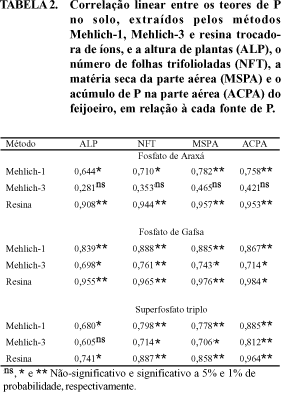With the objective of evaluating the efficiency of three phosphorus extractors in two Mato Grosso do Sul State oxisols, in Brazil, one greenhouse experiment was carried out with three P sources (triple superphosphate, Araxá rock phosphate and Gafsa rock phosphate), all in five levels (0, 50, 150, 450, and 600 mg per kg of soil). Common bean was used as test plant. In order to evaluate the phosphorus availability in the soils, the dry matter yield, the above ground phosphorus content, the plants height and the number of trifoliate leaves were correlated with the extracted phosphorus by Mehlich-1, Mehlich-3 and ion exchange resin methods. Mehlich-3 and resin were more sensitive to soil variations. According to their efficiencies, the extractors were classified in the following order: resin > Mehlich-3 > Mehlich-1. The resin method showed the best correlations with the plants characteristics, thus showing to be the most suitable in forecasting the available P in different soils and P sources. The best correlations were yielded by the resin and Mehlich-3 methods.
soils; phosphates; extraction methods; Mehlich-1; Mehlich-3; resin; edible beans





